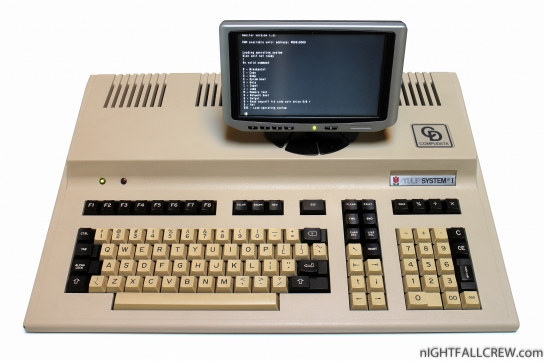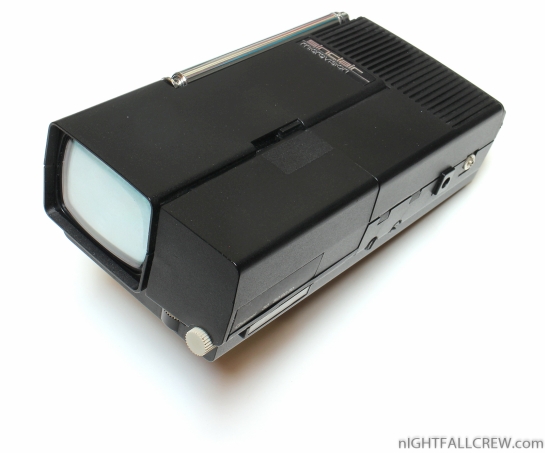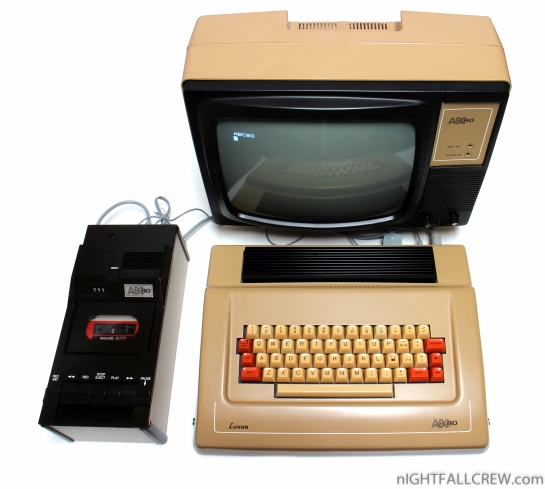Archive
Al-Alamiah (Sakhr) AX-370 (Arabic MSX 2)
Sakhr Computers was a Kuwaiti company (Al Alamiah co.) that was selling MSX computers imported from Japan in all of the Arab world. These MSX were localized and rebranded for some Arabic markets.
The AX-370 is the Sanyo WAVY PHC-70FD MSX2+ computer localised by Al Alamiah with more RAM (128kB instead of 64kB). This machine has an Arabic QWERTY keyboard.
The Rensha controller (autofire), the Pause key and the X-BASIC (or Turbo-Basic) have been removed, the MSX2+ bios roms have been replaced by MSX2 roms, but there’s still the MSX2+ videochip, the Yamaha V9958. It means that software using in language machine the MSX2+ features, especially SCREEN 10 to 12 and the horizontal scrolling, can be runned on this MSX2 computer.
This machine comes with version 2.03 of Arabic firmware, present on all Sakhr/Al Alamiah computers. The firmware can be skipped by pressing CTRL key while booting and until you come on the MSX-BASIC screen. By doing that, the machine will be in International mode and the Arabic characters will not be available.
However, from MSX-BASIC, you can fully enable the Arabic mode with CALL ARABIC, _ ARABIC, CALL ARABON or _ ARABON. It is also possible to keep the Arabic BASIC active without the other Arabic features by entering first CALL ARABIC or _ ARABIC, then CALL ARABOFF or _ ARABOFF.
This firmware adds Arabic characters, new MSX-BASIC commands (see Arabic BASIC) and 4 applications. You can choose them in the menu with the keys 1 to 4.
By comparison with version 2.02, a new application has been added, it’s Sakhr BASIC or how to use BASIC directly in Arabic language. Other options are Word Processor with choice between English or Arabic Word Processor, the Arabic version of The Painter, a graphic tool in screen 5 (the original version can be found in the Yamaha YIS-805) and the Calendar.
If you press key 5 when you are in the menu, you will go to MSX-BASIC. Going back to the menu is possible with CALL MENU or _ MENU. From MSX-BASIC, the Word Processor can be launched with CALL SWP or _ SWP, Sakhr Basic with CALL SBASIC or _ SBASIC, The Painter with CALL PAINT or _ PAINT, the Calendar with CALL CALENDAR or _ CALENDAR.
If you are in International mode, only CALL SWP or _SWP can be used, you will directly go to the English (or French) Word Processor. It’s not recommended to use the other commands without first enabling the Arabic mode.
Gallery:
Gallery of Cleaning and Testing:
source: msx.org
Yaguana (Russian) Sinclair ZX Spectrum Clone
Noname (Russian) Sinclair ZX Spectrum Clone
Didaktik Skalica Co. (Czechoslovakia) Sinclair ZX Spectrum Clone
Bi Am (Russian) Sinclair ZX Spectrum 48-64 Clone
Soviet LENINGRAD – Sinclair ZX Spectrum Clone
A friend of mine left me some ZX Spectrum clones produced in the 90′s in Czechoslovakia and Russia.
As you can see from the photos i have tried to find the right pinout of the RGB video and audio output.
Thanks again Andrea Pierdomenico.
Gallery:
source: https://k1.spdns.de/Vintage/Sinclair/82/Clones/Russia/LENINGRAD/
Tulip Computers (CompuData) Tulip System 1

The Tulip system I was a 16-bit personal computer based on the Intel 8086 and made by Tulip Computers, formerly an import company for the Exidy Sorcerer, called CompuData Systems.
Its 6845-based video display controller could display 80×24 text in 8 different fonts for supporting different languages, including a (Videotex based) font for 2×3 pseudo graphic symbols for displaying 160×72 pixel graphics in text mode. The video display generator could also display graphics with a 384×288 or 768×288 (color) or 768×576 (monochrome) pixel resolution using its built-in NEC 7220 video display Coprocessor, which had hardware supported drawing functions, with a very advanced set of bit-block transfers, it could do line generating, arc, circle, ellipse, ellipse arc, filled arc, filled circle, filled ellipse, filled elliptical arc and many other varied commands.
Its memory could be upgraded in units of 128 KB up to 896 KB (much more than the 640 KB of the original PC).
It included a SASI hard disk interface (a predecessor of the SCSI-standard) and was optionally delivered with a 5 MB or 10 MB hard disk. The floppy disk size was 400 KB (10 sectors, instead of 8 or 9 with the IBM PC) or 800kb (80 tracks).
It ran at 8 MHz, almost twice the speed of the IBM PC XT which was launched only a few months earlier in July 1983. It had the possibility to use an 8087 coprocessor for math, which increased the speed to > 200 kflops, which was near mainframe data at that time.
After initially using CP/M-86 it quickly switched to using generic MS-DOS 2.00. There was a rudimentary IBM-BIOS-emulator, which allowed the user to use WordStar and a few other IBM-PC software, but Compudata B.V. shipped WordStar and some other software as adopted software for this computer. There was a programming support by Compudata B.V. with MS-Basic, MS-Pascal and MS-Fortran. On a private base, TeX and Turbo Pascal were ported to the Tulip System 1.
Gallery:
Works that i have made before power on the computer:
- Removing the filter capacitor inside the power supply.
- Replaced the tantalum capacitors.
- Eprom (ROM) dump.
- Found the pinout for the Video composite signal.
- Cleaning.
Pinout for the Video composite:
Download:
source: wikipedia
Zenith Data System Monitor ZVM-122-EA (Amber Phosphor)
Zenith Data Systems (ZDS) was a division of Zenith Electronics founded in 1979 after Zenith acquired Heathkit, which had, in 1977, entered the personal computer market.
Headquartered in Benton Harbor, Michigan, Zenith sold personal computers under both the Heath/Zenith and Zenith Data Systems names.
Gallery:
Sinclair Microvision MTV1B

This is a Sinclair Microvision MTV1B. It’s the second attempt of Clive Sinclair’s to make a small portable television.
Released in 1978, it was the smallest television in the world with a CRT tube. A teeny-tiny 2″ D5-100w CRT made by Telefunken. Powered by 4 x AA or via External Powersupply at 6v DC (Negative at the center of the power connector).
Gallery:
Luxor ABC 80 (Boxed)

The ABC 80 (Advanced BASIC Computer 80) was a home computer engineered by the Swedish corporation Dataindustrier AB (DIAB) and manufactured by Luxor in Motala, Sweden in the late 1970s (first model August 1978) and early 1980s. It was based on the Zilog Z80 running at 3 MHz and had 16 KB RAM, expandable to 32 KB, and 16 KB ROM containing a fast semi-compiling BASIC interpreter.
ABC 80 normally used a dedicated (included) tape recorder for program and data storage, but could also be expanded to handle disk drives (and many other peripherals). Some sound effects could be produced by a Texas Instruments SN76477 sound chip which was connected to an 8-bit output port, but there was no way to control the chip’s features in any detail, so sound was limited to 96 fixed sounds. The monitor was a black and white TV set modified for the purpose (an obvious choice since Luxor also made TVs). The computer had excellent I/O response times, something that was discovered when trying to upgrade to personal computers. The solution was to use a microcontroller that communicated with a PC. The main unit had a reset button as well.
ABC 80 was also manufactured on license as BRG ABC80 by Budapesti Rádiótechnikai Gyár in Hungary. It used the same keyboard, but the case was metal instead of plastic.
The ABC 80 was a huge hit in Sweden, and grasped a majority share of the rising personal computer market thanks to its office software in Swedish. Although the ABC 80 fans would defend the ABC 80 by referring to its good BASIC and usable extension bus, it couldn’t defend the home market against the gaming computers with color graphics and better sound that arrived in the early 80s like the Commodore 64, even though a new cheaper version was released that could use an ordinary TV instead of the dedicated video-monitor.
Luxor held on to its office market for a couple of years longer with the ABC 800 series, which had a more extensive BASIC, more memory and a 512×240 ‘high-resolution’ graphics mode, but otherwise similar performance. In 1985 Luxor also tried to compete in the office market against the IBM PC with its ill-fated ABC 1600 and ABC 9000 series UNIX computers, but failed.
Gallery:
… and the boxes
Software:
source: wikipedia
Commodore CBM 4008
The Commodore PET 4000 series features Basic 4.0 as a standard feature, along with more memory and a lower price that made them attractive to schools.
Elementary, Middle, and High Schools all over Canada and the United States were filled with these impressive lumbering beasts. Introducing children far and wide to the wonders of BASIC programming. Another lesson taught was the importance of patience, since many schools provided only a tape datasette for loading and saving work.
Like the other models of PET, the 4000 series includes dual datasette ports, though only one is exposed to the outside of the casing. A standard IEEE-488 interface in the back allows the PET to connect to the numerous (and heavy) disk drives and printers being produced by Commodore and other manufacturers.
The PET also has a fully programmable bi-directional parallel interface called the “User” port, which allows the PET to connect and control almost any device one could dream up! The greatest feature, however, is the friendly READY prompt, and the well-laid out keyboard with graphic characters only a keypress away! Pictured here is the PET 4016.
Interestingly, although Commodore provided 8, 16, and 32k versions of their PET 2001 and 3001 series, they had a hard time getting people to purchase higher memory versions as an upgrade. It seemed that people were soldering in their own memory chips onto PET 2001 and 3001 8k and 16k models to upgrade them to 32k. To help prevent this, Commodore sold many PET 4008 and PET 4016 models with the empty memory sockets punched out and destroyed! This encouraged those who wanted more memory to upgrade to the 4032 instead of doing it themselves.
Gallery:
source: zimmers.net
C4CPC cartridge replacement for the Amstrad Plus range & GX4000
C4CPC is a cartridge replacement for the Amstrad Plus range and the GX4000.
Using a micro-SD card storing cartridge images it also allows direct loading of the cartridge from a PC (Windows/Linux/OSX) through USB.
Features:
- Direct access to 16 cartridges selected by dip switches. Cartridge can be up to 512kB.
- Access to unlimited number of cartridge images using the provided selector cartridge.
- Direct cartridge loading from host computer using USB.
- Cartridge file can be in standard .cpr format or raw binary .bin
- Integrated ACID.
Gallery:
Download: C4CPC GX4000 microSD Games & Demos (1363)
source: cpcwiki.eu
Commodore SX-64 USA (NTSC) – Repairing and Cleaning
A big disappointing this Commodore SX-64 USA purchased for spare parts to fix aesthetically one of my SX-64 PAL.
Why disappointing? because from the photo’s looked in a very bad shape, rust stains, various diseases and not working.
Conversely after removed the shit from the external case, replaced the booring PLA (906114), general cleaning + keyboard / Floppy Drive test and replaced one keyboard lock, the SX-64 is fully working and aesthetically in good condition.
Now i have for myself four SX-64 where the fourth is NTSC/USA, but honestly i was not looking for the USA version.
I am really unlucky :D
Gallery of the cleaning and repairing:
Australian Commodore 64 (replacement case for the C64)
The Commodore 64 Australian is an replacement case for the C64.
It’s an C64c look-a-like and was sold in Australia. This replacement case came on the market when Commodore introduced it’s new model, the C64C.
Gallery:
































Recent Comments